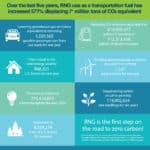Renewable Natural Gas Is Driving Down Emissions
The steady adoption of natural gas vehicles in heavy- and medium-duty fleets is helping to drive increased use of renewable natural gas in our fleets. Proven natural gas vehicle engine technology now runs 90% cleaner than the current U.S. EPA standards. Fueling NGVs with biomethane (RNG) improves emissions even further. Waste-derived gas is captured and conditioned above ground, yielding ultra-low, carbon-neutral, or even carbon-negative lifecycle emissions. In 2018, 32% of all natural gas used in transportation was renewable natural gas and, in 2019, that figure is expected to approach 40%.1
Over the last five years, the use of RNG as a transportation fuel has increased 577%, displacing 7+ million tons of carbon dioxide equivalent (CO2e) through the end of 2018.2 To put this in perspective, the increased use of renewable natural gas as a transportation fuel is equivalent3 to the following:
• Lowering greenhouse gas emissions equivalent to removing 1,539,565 gasoline passenger cars from our roads for one year.
• Reducing CO2 emissions equivalent to 815,950,377 gallons of gasoline or 712,313,458 gallons of diesel consumed.
• Equal to the total energy used by 868,321 U.S. homes for one year.
• Avoiding greenhouse gas emissions equivalent to running 1,537 wind turbines for one year.
• Like replacing 275,434,003 traditional light bulbs with LEDs.
• Sequestering carbon equal to growing 119,902,624 tree seedlings for ten years or 8,534,274 acres of U.S. forests for one year.
For heavy- and medium-duty fleets, other alternative options such as electric offer a future promise and a dream but renewable natural gas offers the immediate reality of abundance, availability and favorable economics while delivering cleaner air right now.
Choose Cleaner. Choose Healthier. Choose Renewable Natural Gas. #CleanFleetMonth
1 Source: U.S. Energy Information Administration’s Annual Energy Outlook 2017, 2018, 2019 and the Coalition for Renewable Natural Gas
2 Note: GGE = gasoline gallon equivalent. EGE= ethanol gallon equivalent. EGE units are converted to GGE using a 0.67 multiplier (77,000 Btu/115,000 Btu). Total Natural Gas in Transportation Figure derived from U.S. EIA’s Annual Energy Outlook (2019). RNG numbers derived from U.S. EPA RFS Reporting. Total greenhouse gas emissions and associated carbon dioxide equivalent (CO2e) metric tons identified using the California Air Resources Board’s Low Carbon Fuel Standard carbon intensity scores as well as the U.S. DOE’s Argonne National Laboratory Heavy-Duty Vehicle Emission Calculator.
3 Note: Assumes 7,251,351 metric tons of CO2e reduced over last five years through increased RNG usage calculated using CARB’s LCFS carbon intensity numbers. GHG equivalency results calculated using the U.S. EPA’s calculator.

